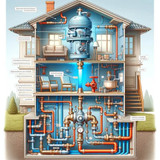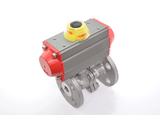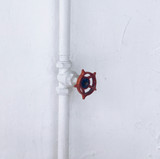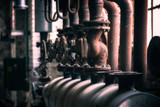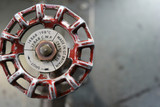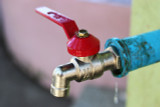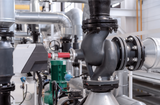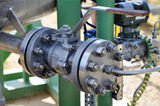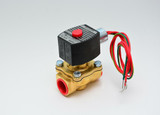Sanitary Ball Valves
Sanitary ball valves are essential for industries demanding high cleanliness. Unlike standard valves, they boast a polished, full-bore design for smooth flow and are compliant with prescribed hygiene standards. A rotating ball with a hole through its center controls flow: aligned for open, perpendicular for shut. This ensures leak-proof operation, ideal for sterile environments.
Sanitary ball valves are key players in:
- Food & Beverage: Maintaining product purity throughout processing.
- Pharmaceuticals: Controlling sterile fluids and materials in drug production.
- Chemical Processing: Regulating product flow while preventing contamination.
Their user-friendly operation (often a simple quarter-turn), actuation options, full-port design and easy cleaning make them a reliable choice for applications where hygiene requirements reign supreme.
Benefits of Sanitary Ball Valves
Leak-Proof Performance
Sanitary ball valves are renowned for their ability to shut off flow completely. The key lies in their robust design. A precisely machined ball with a smooth, polished surface forms a tight seal against the valve seats when closed. This ensures no leaks, preventing contamination of your product and potential product loss.
Easy Operation
Operating a sanitary ball valve is a breeze. Unlike some valves with complex mechanisms, sanitary ball valves typically use a lever or handle. With a simple quarter-turn (90 degrees), you can switch the valve between fully open and completely closed states. This user-friendly design makes them ideal for applications requiring frequent flow control adjustments. Actuation options are available as well, allowing for remote and automated process control.
Minimal Pressure Drop
Sanitary ball valves are designed to minimize restrictions on fluid flow. They achieve this through two key features:
Full-Bore Design: Unlike some valve types that narrow the flow path, sanitary ball valves have a full-bore design. This means the opening through the valve has the same diameter as the pipe it connects to. This minimizes resistance and allows for smooth, efficient flow, even for viscous fluids or those containing particles.
Smooth, Polished Surfaces: The polished surfaces of a sanitary ball valve minimize friction between the fluid and the valve interior. This reduces pressure loss as the fluid passes through the valve, ensuring optimal flow efficiency in your system.
Easy Cleaning and Maintenance
Maintaining a sanitary environment is crucial in many industries. Sanitary ball valves are designed with this in mind. Here's how they promote easy cleaning and maintenance:
Polished Surfaces: As mentioned earlier, the smooth, polished surfaces of the valve minimize areas where bacteria or contaminants can hide. This allows for easier cleaning and reduces the risk of product spoilage. Seats and cavity fillers are made from approved hygienic elastomers which limits contamination and media entrapment.
Full-Bore Design: The full-bore design facilitates easy access for cleaning tools or pigging devices, and eliminates hidden crevices where debris might accumulate.
Maintenance-friendly Design: Many sanitary ball valve connections are designed to be easily disassembled for thorough cleaning and inspection. This allows for complete access to all internal surfaces for a rigorous cleaning regime.
Applications of Sanitary Ball Valves
Sanitary ball valves are the go-to choice for industries where hygiene is paramount and contamination is a major concern. We've covered some key applications, but their use cases extend even further:
Food and Beverage
From controlling the flow of ingredients and finished products to managing cleaning solutions, sanitary ball valves ensure product safety and hygiene standards are maintained during food and beverage manufacturing and transport processes.
Pharmaceutical
Maintaining a sterile environment is critical in drug manufacturing. Sanitary ball valves control the flow of fluids, powders, and other materials used in high-purity pharmaceutical production environments.
Chemical Processing
Precise control and contamination prevention are essential for many chemical processes. Sanitary ball valves excel in these applications due to their reliable shutoff and easy cleaning capabilities.
Choosing Your Sanitary Ball Valve: Key Factors
Selecting the perfect sanitary ball valve requires considering a few key points:
Material: Most commonly 316L stainless steel for excellent corrosion resistance. Consider Alloy 2205 for saltwater or Hastelloy C-22 for harsh chemicals.
Size & Connection: Pick a port size matching your pipes and choose a connection type like Tri-Clamps for easy use or flanges for high pressure. Choosing the right connection helps to prevent external contamination.
Pressure & Temperature: Ensure the valve's temperature and pressure ratings exceed your system requirements, to prevent leaks, rupture and damage to people, equipment or the environment.
Actuation: Choose between manual, electric, pneumatic or hydraulic actuation options to suit your process requirements and provide the level of automation you need.
Find the Perfect Sanitary Ball Valves at ValveMan!
Sanitary ball valves stand out for their reliable shutoff. Their leak-proof design ensures product integrity and prevents contamination. They’re also very straightforward to operate - easy quarter-turn operation makes flow regulation a breeze.
Another of their main features is an efficient flow profile, which means that the full-bore design and smooth surfaces minimize pressure drop allowing for optimal flow through the valve. Sanitary ball valves are also known for their hygienic design, with polished surfaces, cavity filled seats and accessibility for easy cleaning some of the features that promote a sanitary environment.
These valves are the perfect choice for applications demanding top-notch hygiene standards and reliable flow control. From food and beverage to pharmaceuticals and beyond, sanitary ball valves ensure your processes operate smoothly and safely.
When choosing ValveMan as your sanitary ball valve supplier, you're investing in unmatched quality and reliability. Our valves undergo thorough testing to meet rigorous industry standards, ensuring you receive only the best. With a global distribution network and a commitment to compliance with all relevant industry regulations, including lead-free requirements, ValveMan guarantees timely delivery and exceptional customer support worldwide.
Do you need a sanitary ball valve for your project? Contact us here at ValveMan and request a quote today!
Bibliography
- Burton, S. J., Lelievre, J., Milligan, S., & Wong, A. (2014). Design and selection of sanitary valves for the biopharmaceutical industry. BioProcess International, 12(8), 34-40.
- European Hygienic Engineering & Design Group. (2018). EHEDG Guidelines.
- Yokogawa Electric Corporation. (2006). A Guide to Sanitary Ball Valves [Technical Bulletin TB211A-01].
- Yamada, K., & Shirato, M. (2001). Fluid mechanics of a sanitary ball valve. Journal of Chemical Engineering of Japan, 34(1), 121-127.
Our Posts
View AllUnderstanding Valve Sizes and Measurement
Sizing the appropriate valve is critical to ensuring the performance of your system. Whether you'r …
Read MoreTypes of Water Valves
Hey there, fellow valve enthusiasts! We all know that valves play a crucial role in regulating th …
Read MoreWhat is a Backflow Preventer, and How Does it Work?
When a simple check valve is inadequate for the job, you need a backflow preventer. But knowing …
Read MoreValve inspection - main points of valve testing in Manufacture setting
Industrial facilities rely on different types of valves (such as check valves, for example) to con …
Read MoreTypes of Ball Valves
Ball valves are important components in a vast range of systems, from small family-owned workshops …
Read MoreUnderstanding valve standards and specifications
Hey there, fellow valve enthusiasts! Today, we're looking at valve codes, standards and specifica …
Read MoreHow to Tell if a Valve is On or Off
We have all been there before. You are staring at a valve; you know that you should know if it …
Read MoreUnderstanding Different Types of Valve Connections and Fittings
Hey there, fellow valve enthusiasts! We know valves play a crucial role in regulating the flow of li …
Read MoreTypes of Valve Handles: Lever and Handwheels
Whether you're involved in industrial work, plumbing, or you're a DIY enthusiast, you come across va …
Read MoreThe Basic Parts of a Valve
Valves quietly work in many different areas, even places you wouldn't expect. They're truly every …
Read MoreGas Ball Valves In Industrial Applications - 5 Things to Keep in Mind
Unlike the standard ball valves, most gas ball valves are tested and approved by CSA. These valves a …
Read MoreHow To Correctly Use A 3 Way Valve In Different Applications
To understand the "T"-port and an "L"-port 3-way valves and what makes them different, it's importan …
Read MoreIndustrial Ball Valves - 9 Questions To Make The Right Choice
Ball valves are versatile flow control devices suitable for extensive industrial applications. They …
Read MoreEverything you need to know about valve types
Valves play crucial roles in production lines and equipment performance across a multitude of ind …
Read MoreWhat is a Duty Cycle and How Does it Relate to Electric Ball Valves?
Electric actuation improves the efficiency of processes by maintaining the accuracy of the re …
Read MoreActuated Butterfly Valves 101: All You Need To Know About Their Application In Piping Systems
Butterfly valves are quarter-turn flow control or isolation devices, used for quick shut-off in p …
Read MorePractical Guide To Electric and Pneumatic Actuators – Which One To Choose?
While electrical and pneumatic actuators have several unique benefits and are preferred in differ …
Read MoreHow Do Check Valves Affect Water Pressure in the Piping System?
Check valves also known as "one-way" valves are autonomously operated unidirectional valves that all …
Read MoreUsing an Actuated Ball Valve Or a Solenoid Valve For Best Fluid Control In The System
Both ball valves and solenoid valves serve a wide variety of applications. From a&nb …
Read MoreWhat are the types of solenoid valves?
Favored for offering low power consumption, a compact space envelope, superior speed of ope …
Read More

